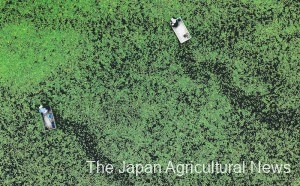AKITA, Jun. 30 – A traditional summer product, junsai, is in the peak harvest season in Mitane-cho, Akita Prefecture. The town is Japan’s largest producer of junsai, a perennial aquatic plant of the Nymphaeaceae family known as water shield in English. The harvest season will continue until August.
The slippery vegetable appears in an old poem by Kenji Miyazawa, The Last Farewell. People eat the sprout that grows in water and is covered in a viscous jelly. The transparent jelly shines like ice, refreshingly, and people like it for its unique springy texture and smoothness.
It was once a natural product found in swamps in Mitane-cho. However, in the 1970s, local rice farmers began growing it instead of rice after the implementation of the rice acreage reduction policy. The Shirakami-Sanchi World Heritage Site provides abundant, clean water, making the town suitable for junsai farming. Junsai production in Mitane peaked in 1991 at 1,260 tons, accounting for approximately 90% of the junsai consumed throughout Japan.
A local agricultural cooperative in Akita, JA Akita Yamamoto, has a group of 50 junsai farmers. In 2024, they produced 16 tons. The 66-year-old head of the junsai growers’ group, Koichi Ando, owns four swamps, 9,000 square meters in total, to grow junsai. At 4:30 a.m., he gets on his wooden boat to harvest junsai in water 0.5 to 1 meter deep. Younger sprouts have more jelly, and the grown leaves have less. So very new sprouts are the most expensive.
Ando starts harvesting at sunrise, as it is also the fruit thinning season for the peaches he grows. On rainy days, he still gets on the boat wearing a raincoat. “The keys to making jelly thicker are clean water and good care,” he said. So, he cleans his swamps that use underground water once every 10 days. He cannot use weed-killers, so he gets rid of weeds by hand.
At a local junsai-specialized farmers’ market, Junsai-no-Yakata (Junsai House), more than 100 people were waiting in line for the store’s opening. Since everyone was there for junsai, the hundreds of bags on display were sold out in no time. Many bought several as gifts for families and friends living outside Akita.
“I hope people enjoy its unique, smooth texture. Also, please explore various ways to enjoy it,” Ando said. He likes eating lightly-boiled junsai with wasabi soy sauce or miso soup with junsai, he added.


